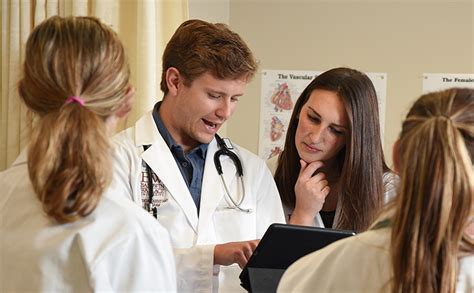Overview
Baldwin Wallace University’s Physician Assistant (PA) Program is designed to prepare highly skilled clinicians for the dynamic field of healthcare. This rigorous 28-month master’s program offers a comprehensive curriculum that combines academic coursework, clinical rotations, and research experiences.

Program Highlights
- Accreditation: Accredited by the Accreditation Review Commission on Education for the Physician Assistant (ARC-PA)
- Small Class Size: Intimate learning environment with an average class size of 24 students
- Experienced Faculty: Dedicated instructors with extensive clinical and research expertise
- State-of-the-Art Facilities: Access to a dedicated PA Simulation Lab, Clinical Skills Lab, and Anatomy Lab
- Clinical Rotations: Over 1,800 clinical hours in diverse settings, including primary care, internal medicine, surgery, emergency medicine, and pediatrics
- Research Opportunities: Participate in faculty-mentored research projects that contribute to the advancement of PA practice
Curriculum
The Baldwin Wallace PA curriculum strikes a balance between theoretical knowledge and practical skills. Students complete coursework in the following areas:
- Medical Sciences: Anatomy, Physiology, Pharmacology, Pathology
- Clinical Medicine: Physical Diagnosis, Medical History, Patient Management
- Behavioral Sciences: Psychology, Sociology, Ethics
- Research Methods: Research Design, Data Analysis, Statistical Interpretation
- Professional Development: Leadership, Communication, Intercultural Sensitivity
Clinical Rotations
Clinical rotations are an integral part of the PA program. Students gain hands-on experience in various healthcare settings, including:
- Primary Care: Family medicine, internal medicine, pediatrics
- Surgical Specialties: General surgery, orthopedics, plastic surgery
- Emergency Medicine: Emergency rooms, trauma centers
- Other Specialties: Dermatology, ophthalmology, neurology
Research Opportunities
Baldwin Wallace encourages students to engage in research. Students work closely with faculty mentors on projects that address real-world healthcare challenges. Past research topics include:
- The Impact of Telemedicine on Rural Healthcare Access
- The Role of PAs in the Management of Chronic Diseases
- The Development of Educational Interventions to Improve Patient Health Literacy
Career Prospects
Graduates of the Baldwin Wallace PA Program are highly sought after by healthcare employers. PAs enjoy a wide range of career opportunities in various settings, including:
- Hospitals
- Clinics
- Private Practices
- Schools
- Correctional Facilities
- Rural Communities
Program Stats
- Graduation Rate: 99%
- PA Licensure Pass Rate: 95%
- Median Starting Salary: $105,000 (Source: Bureau of Labor Statistics)
Why Choose Baldwin Wallace PA Program?
- Clinical Excellence: Baldwin Wallace’s PA program prepares graduates to provide high-quality patient care in a variety of settings.
- Academic Rigor: The rigorous curriculum provides students with a strong foundation in medical and clinical knowledge.
- Student Support: The program offers a dedicated Academic Success Center, peer tutoring, and personalized advising.
- Community Engagement: Students participate in community health outreach programs and volunteer activities.
- Alumni Network: Baldwin Wallace boasts a strong alumni network that provides career support and networking opportunities.
Table 1: Program Milestones
| Milestone | Timeline |
|---|---|
| Coursework | 18 months |
| Clinical Rotations | 12 months |
| Research Project | Ongoing throughout the program |
| Graduation | 28 months |
Table 2: Clinical Rotation Sites
| Rotation Type | Sites |
|---|---|
| Primary Care | Local family medicine and internal medicine clinics |
| Surgery | University Hospitals Cleveland Medical Center, Cleveland Clinic |
| Emergency Medicine | University Hospitals Cleveland Medical Center, Cleveland Clinic Fairview Hospital |
| Other Specialties | Variety of specialized clinics and hospitals |
Table 3: Research Project Topics
| Area of Focus | Examples |
|---|---|
| Healthcare Access | Telemedicine for underserved populations, barriers to care |
| Chronic Disease Management | Diabetes education, hypertension control, cancer screening |
| Patient Education | Health literacy interventions, cultural sensitivity training |
Table 4: Career Opportunities
| Setting | Job Titles |
|---|---|
| Hospitals | Emergency Department PA, Hospitalist PA, Surgical PA |
| Clinics | Primary Care PA, Urgent Care PA, Specialty Clinic PA |
| Private Practices | Family Practice PA, Internal Medicine PA, Pediatrics PA |
| Schools | School Physician, Athletic Trainer PA |
| Other | Correctional Healthcare PA, Military PA, Research PA |
FAQs
1. What are the prerequisites for the PA program?
Bachelor’s degree in any field, minimum GPA of 3.0, completion of prerequisite science courses (biology, chemistry, etc.).
2. How long does the program take to complete?
28 months, including 18 months of coursework and 12 months of clinical rotations.
3. What is the cost of the program?
Tuition and fees vary based on program length and student status. Contact the Admissions Office for current costs.
4. What is the job outlook for PAs?
The U.S. Bureau of Labor Statistics projects a 31% growth in PA jobs between 2019 and 2029.
5. What is the first step in applying to the program?
Submit an online application along with transcripts, personal statement, and letters of recommendation.
6. Can I work while attending the program?
Part-time work may be possible, but the program’s rigorous schedule requires a significant time commitment.
7. What is the difference between a PA and a physician?
PAs are licensed healthcare professionals who work under the supervision of physicians. They perform a wide range of medical tasks, including diagnosing and treating illnesses, prescribing medications, and providing patient education.
8. Where can I learn more about the Baldwin Wallace PA program?
Visit the program website at www.bw.edu/pa or contact the Admissions Office at 440-826-2000.
